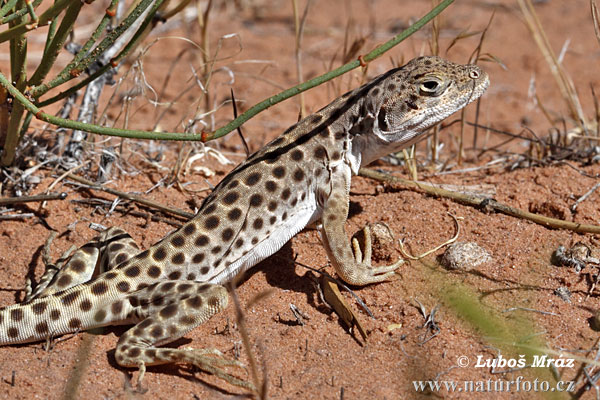Post by Ceratodromeus on May 20, 2015 22:56:08 GMT 5

Scientific classification:
Kingdom: Animalia
Phylum: Chordata
Subphylum: Vertebrata
Class: Reptilia
Order: Squamata
Suborder: Iguania
Family: Crotaphytidae
Genus: Gambelia
Species: G. wislizenii
Description: This is a relatively large species of desert dwelling lizard. They are sexually dimorphic, with females attaining 5.5in in SVL, with males attaining lengths of 4-4.5in SVL. Standard coloration for the species is a dull brown with a series of a chocolate brown leopard like spots.Individuals in the breeding season obtain hues of orange, white, and blue.
Geographic range: These lizards can be found in the semi arid deserts of Nevada, California, Arizona, and even down into Mexico.

Dietary habits: The diet of the long nosed leopard lizard varies greatly throughout Populations. It is an oppurtunistic predator, taking a great range of prey animals. Lizards are primarily taken, though snakes, rodents, Spiders, cicadas, grasshoppers, bees, and yellow jackets have all been noted as part of G. wizlienii's diet.{1} The way in which the long nosed lizard predates on prey with stingers(e.g. bees) and those without(e.g. cicadas) has been noted to be vastly different. Prey with no stinger is rushed head on, the head usually targeted and subsequently crushed. Those prey animals with stingers were observed, circled, and sometimes nipped at before eventually being exhausted and consumed by the lizard.{2}

Predation on a desert iguana(Dipsosaurus dorsalis)
Behaviors: These lizards spend most of their time amongst large rocks sunning themselves. When they sense a threat is near, they will run under a nearby bush and remain motionless, sometimes pressing themselves against the substrate in an attempt to blend in. They will remain in said posture until the perceived threat is gone. If they are captured( be it by human or predator) they will either bite, or they will cast its tail off (caudal autotomy).These lizards are also capable of running at high speeds, and will do so if left with little options. These lizard are also known to be rather vocal. When harassed, they have been noted to make sounds likened to squealing.{3}
Reproduction: Breeding occurs from May to June, with the eggs being laid from June to July. They subsequently hatch one to two months later. Clutch sizes ranged from 2 to 6 eggs. The young share the characteristic coloration of the adults, albeit with slightly more contrasting patterning.
References:
{1}Rose, Eleanor Louisa. Foraging Behavior in Gambella Wislizenii, the Long-nosed Leopard Lizard, in Harney County, Oregon. Diss. Western Washington University, 2004.
{2}Anderson, R., and E. Rose. "Variation in food acquisition behavior of an ambush predator: patterns and correlates." INTEGRATIVE AND COMPARATIVE BIOLOGY. Vol. 46. JOURNALS DEPT, 2001 EVANS RD, CARY, NC 27513 USA: OXFORD UNIV PRESS INC, 2006.
{3}Crowley, Shawn R., and Robert D. Pietruszka. "Aggressiveness and vocalization in the leopard lizard (Gambelia wislizennii): the influence of temperature." Animal Behaviour 31.4 (1983): 1055-1060.





